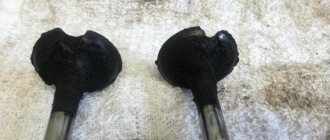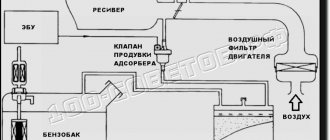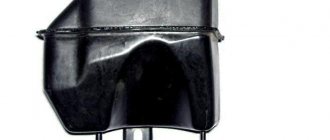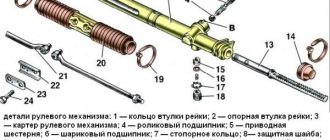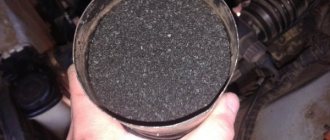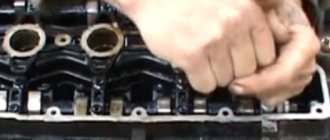The design of the gas distribution system of most internal combustion engines includes a valve system. It regulates the timely flow of air or combustible mixture into the combustion chamber and the release of exhaust gases. The valve itself constantly operates in aggressive conditions under the influence of high pressures and temperatures, which destroy the body of the part, leading to engine failure. There are certain reasons and conditions under which valve burnout occurs much faster than the design period of operation.
Causes of high temperature damage
Experts identify various factors that have a direct impact on the integrity of parts. The most popular among them are:
- Extremely high temperatures. Automakers calculate the characteristics of the unit in such a way that it functions most of the time at 600-650C. In the case where there are malfunctions of the heat sink, excessive overheating is fraught with destruction.
- Manufacturing defects. Although all parts leaving the factory assembly line undergo strict control, there remains a low risk of defective parts. It can be determined independently by the heterogeneity of the metal, microcracks, defects in welding seams, etc.
- Low quality fuel. Running a lean fuel mixture may be the reason why valves burn out. The lack of fuel in the mixture is ruined by temperature fluctuations.
- Availability of connected gas equipment. Engines using gas as an alternative fuel are characterized by significant loads on gas distribution systems. Power plants with a poor gas supply are at risk. We recommend calibration at least every 12-14 thousand kilometers.
A high percentage of defective spare parts is a problem for the motorist
These are not the main reasons why valves burn out. The leading manufacturer of these parts conducted a small study, and the statistics were not happy - every fifth part that is produced breaks or burns out due to the human factor and defects. And even modern product quality control at factories does not guarantee that the part is free of any defects.
Another reason is metallurgical inhomogeneities that are included in the alloy. These irregularities make the valve weaker than it should be. In addition, there are manufacturing defects, namely forging. This leads to microcracks. Errors in the heat treatment process lead to changes in the dimensions of the product.
How will the engine work and what will happen if the valves are clamped?
How to understand that the valve is jammed
If after starting the engine runs normally, but during long operation the thrust drops - this is a symptom of pinched valves. Another sign of jammed valves can be shots into the muffler when releasing gas. Because The combustion chamber is not completely closed, compression decreases and a disruption in the working process occurs. When adjusting, it is better to exceed the permissible gap than to make it smaller.
A burnt valve must be repaired as quickly as possible!
The consequence of clamped valves is overheating, increased fuel consumption and, as a result, burnout. It is undesirable to operate the engine with a burnt-out valve; this leads to burnout of the valve seat. What the car owner will end up having to do is replace the entire head.
Compression in the engine
Compression is the pressure that the piston creates in the cylinder when the first one is at top dead center.
What compression should be in the engine depends on the type of engine. For example, for a VAZ-2109, normal compression is considered to be 11 kg/cm3, and for a VAZ-2110 – 13 kg/cm3. For most cars, the compression level is between 11 and 13 kg/cm3. If the measurements show lower numbers, then the motor needs to be diagnosed. Perhaps the valve in it has burnt out.
Replacing burnt out valves
The operation of replacing the valves of different engines is similar, and differs only in the size of the parts and their placement on the cylinder head. Before performing the operation, prepare lapping powder, new valve seals and a new head gasket. After dismantling the cylinder head, operations are performed in the following order:
1. Valve desiccation. To do this, the head is laid out on a flat surface and a rubber mat is placed under the valve. A tube with a diameter of 13 mm is placed on the valve so that the crackers are inside, and blows are applied with a hammer. The valve desiccates, and the crackers remain in the tube. The operation is also easily carried out using a special device that compresses the vein and allows you to pull out the crackers.
- The valve is pulled out, a new one is inserted, and the bushing guide is checked by shaking. If runout is up to 1 mm, the guide is not replaced.
We recommend: How to remove the front and rear bumpers on a VAZ 2110
3. If it is necessary to replace the guide, use a special mandrel. The old part is knocked out in the direction of the camshaft using a half-sledge hammer with a heavy blow so that the part does not crumble. Afterwards, a new bushing is driven into the head, having first put a retaining ring on it.
4. The new valve is secured with a retaining ring and the assembly is lubricated with oil.
5. Valve grinding. The seat is initially treated with a special cutter, after which lapping powder is applied to the edge of the valve, inserted into the head, the other end is clamped into the drill chuck, and by pulling it up and down, the valve is provided with a tight fit to the seat. It is advisable to carry out the operation for all valves.
6. Drying of the valve. To do this, press the spring firmly and insert crackers. The cylinder head is attached to the engine cylinder block.
The described method allows you to replace the burnt valves of all models of the VAZ: 2101, 2102, 2103, 2104, 2105, 2106, 2107, 2108, 2109, 21099, 2110, 2111, 2112, 2113, 2114, Niva, Lada Priora, viburnum, Grant, Grant, Grant. Vesta and most foreign cars.
What is burnout?
Metal destruction under the influence of high temperatures is typical for both diesel and gasoline engines. Even taking into account the fact that most of the important parts of the gas distribution mechanism are made of special high-strength steel grades, under certain conditions they are destroyed.
The actual combustion of the metal is not carried out in the classical form. Parts are destroyed from different sides.
It is important to know that a burnt-out valve can be identified by cracks formed on the edges or by obvious penetrations in the working surface.
Due to the fact that defects form on some coins, the tightness of the interface between the seat and the plate disappears. As a result, this results in engine problems, and can manifest itself in serious damage to the internal combustion engine.
How to determine a bad cylinder?
The essence of the simplest test comes down to sequential shutdown of the cylinders. By simulating a malfunction, we observe changes in engine operation. After turning off the boiler in which the valve has burned out, changes in operation will be minimal. What are the best ways to do this?
Remove the high-voltage wire from the spark plug. At this time, the coil will experience increased loads, so the duration of such a stress test should not exceed 2-3 seconds. To avoid the risk of electric shock through a cracked GDP, such a check should be done wearing rubberized gloves or using pliers with plastic/rubber handles.
Physically disconnect the injector chip. If you have specialized diagnostic equipment, this can be done programmatically by connecting to the car via the OBD-II connector.
What to do if the valve burns out?
In the case of burnt valves, repair consists not only of replacing them, but also of finding out the cause of the burnout. Therefore, the ignition and cooling systems should be checked.
If you have replaced and ground in one valve, take the time to ground in the rest.
You can replace the valve not only at a service station, but also in a garage if you are familiar with the basics of repair.
We recommend: How to set the ignition using a strobe?
Thus, the valve is an important part of the engine, so in order to protect yourself from repairs, it is better to carry out routine maintenance on time.
Signs
The symptoms of a burnt valve coincide one-to-one with a sign of a malfunction in the ignition system. Therefore, very often inexperienced mechanics begin to repair the ignition. At the same time, they change the distributor cap, install new high-voltage wires, spark plugs, and turn on the ignition, but there is no result. The engine has been running every now and then and continues to do so. They, cursing the creators of cars, continue to look for the cause, without even realizing the true cause of the problem. Moreover, even those who guessed that the problem lies in the engine will only find out about the burnt-out valves after removing the cylinder head.
However, there is a way to diagnose this malfunction without disassembling the engine. The search for the cause must occur according to a certain algorithm:
- Ignition is checked
. Here you need to pay attention to the performance of the distributor, the correct ignition timing, and the integrity of the wires; - Identify the problem cylinder. They do this in the following way. One by one, they pull off the high-voltage caps from the spark plugs. If the cylinder is working, the engine will start to stall. The faulty one will not respond to such an action, and the operation of the engine will not change. This should be done carefully. The caps must be removed using insulated pliers;
- After this, compression is measured. Most likely, it will be slightly lower than the required 11 points. But this may be an indicator of both problems with the valves and a malfunction of the piston group.
Usually at this stage, car enthusiasts grab a set of keys and begin to enthusiastically rev up the engine. But there is a way to recognize the true cause of the malfunction without disassembling the engine. It is worth preparing the necessary parts and tools in advance.
This is done as follows:
- First you will need to start the engine. After this, remove the breather hose. Just warm air should come out of it, or, in extreme cases, light smoke. If the smoke is gray and dense, and smells like exhaust, then the cause of poor compression is problems with the piston group. Possible burnout of the piston or sticking of the rings;
- Next, regardless of what you see when removing the hose, you should unscrew the spark plug from the problem cylinder. It should be considered. If the piston is damaged, it will be in oil. A burnt-out valve is easily determined by the absolutely normal condition of the spark plug;
- Remove the cylinder head and replace the damaged part. Even if you are not going to change the entire set of valves, but want to get by with replacing only the damaged one. Be sure to change all oil seals and lap the valves.
Conclusion
. Few drivers know how to correctly identify a burnt valve. Therefore, they spend time and money on completely different parts and components of the car, without solving the main problem. The symptoms and signs of a burnt valve are quite simple. Knowing them, even a novice auto mechanic will be able to make an accurate diagnosis in just 15 minutes.
How to determine a burnt valve in an engine? Many car enthusiasts are faced with the problem of valve burnout, but cannot accurately determine without removing the head. I’ll tell you the easiest way to determine if a valve is burned out. It all starts with the engine starting to misfire, but this problem can be associated with a bunch of reasons, but now let’s look at valve burnout. First you need to determine which cylinder is not working, this can be done in the old and proven way, start the engine and let it idle, start pulling off the caps from the spark plugs one by one, if you pulled off the cap from the spark plugs and the engine changed its speed (began to spin slower or stalls) This means that the cylinder is working. If, when you pull the cap off the spark plug, the engine spins and spins or changes its speed slightly, then this cylinder is not working and you need to find out the cause of the failure. Photo.
